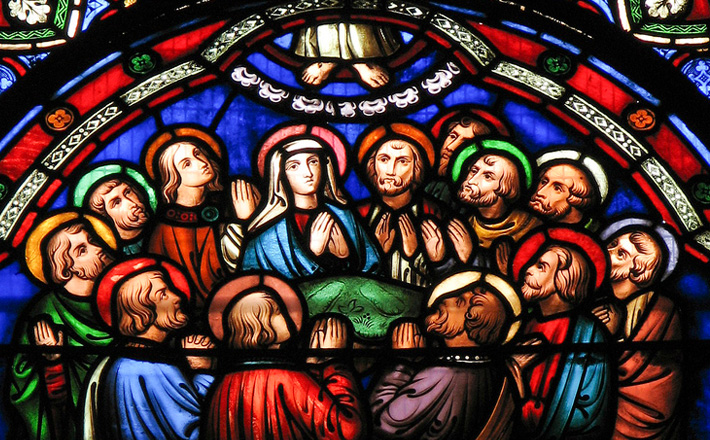Commentary on John 17:1-11
Death is never an easy reality to face.
It is often unexpected, but some of the most challenging situations arise when a group knows that a beloved member of their community will die. Such a dynamic is depicted in Lulu Wang’s The Farewell, in which the family goes to great lengths to hide a terminal diagnosis from their beloved grandmother. The film is a touching and comedic depiction of their efforts to avoid the reality that they will lose their matriarch.
In John’s story, Jesus takes the opposite approach. Throughout the story, Jesus makes explicit references to his coming death. Here, in his final prayer for his disciples, he offers them a final word of comfort and challenge. John’s Farewell Discourse is a lengthy address (taking up chapters 14-17) that serves as the culmination of a narrative that has always been forthright about the fate of its hero.
The Gospel’s early readers likely never knew Jesus on earth, and there are some clues that suggest they were mourning the loss of their own community leader. Read through this lens, Jesus’ prayer is good news for anyone who feels that God is distant, who finds themselves missing connection with the divine, or who is grieving the loss (or worrying about the potential loss) of a loved one.
Unity and love for the world
Two things immediately stand out when reading this passage. First, there is an emphasis on unity or oneness. Throughout the Gospel John emphasizes the unity shared between Jesus and God. Jesus is introduced as the Word who was with God and was God (John 1:1). In this passage, where Jesus offers a final prayer for his disciples, the capacity of that unity expands to include Jesus’ followers.1 Jesus mentions this unity as a visionary hope that his followers would be “one” just as he is one with God (John 17:11). For those who continue reading past the lectionary section, this vision is reiterated in verse 21 “… that they may all be one. As you, Father, are in me and I am in you, may they also be in us.”
At the same time, there is also an emphasis on the world. The “world” has a prominent and complex place in John’s Gospel. It is the creation of God, (John 1:10a; 7:4; 11:27; 12:19), the object of God’s love and work (3:16), but it is often characterized as hostile to God’s work, or the realm that does not know God (1:10b). Jesus prays for the world (17:20-21) and sends the disciples into the world so that the world will no longer be separate from God (17:15-23). Jesus was sent to enlighten the world (1:9), to give life to the world (3:16-17; 6:33, 51), to save the world (4:42; 12:47), and to invite the world to join in the love he shares with God (14:31; 17:23).
We can see that “world” does not mean one thing in John’s gospel, rather, the range of meaning reveals a dynamic movement within the story. The world that was positive in relation to God as God’s creation becomes hostile, opposed to God when it rejects Jesus. But, as the Gospel shows, God works to break down the divide between God and the world as people who encounter Jesus are invited to believe.
John tells us that this is the purpose of the incarnation—God taking on flesh in the person of Jesus. Jesus, a human who is one with God and is God, can create this dynamic movement. It is divine love for the world that drives God’s work in the Gospel (3:16; 13:1; 15:13; 17:23, 26). In one of the Gospel’s most revealing verses, the narrator tells us: “No one has ever seen God. It is God the only Son, who is close to the Father’s heart, who has made him known.”2 1 John 4 picks up this language and extends it: “No one has ever seen God; if we love one another, God lives in us, and God’s love is perfected in us” (1 John 4:12).
The Gospel of John presents Jesus as the one who is one with God, who can do God’s work of closing the distance between God and the world. The epistle takes the image a step further. We are the ones who can show what God is like. No one has ever seen God … but if we love one another God lives in us. When we love one another God’s love is perfected; we can bring God’s love to its intended purpose.
This theme is present in Jesus’ final prayer in John 17 where the disciples’ connection to Jesus grants them his words, and passes his mission on to them. “As you have sent me into the word,” Jesus says, “so I have sent them into the world” (17:18).
God lives in you
This passage ends on a sobering note: “I am no longer in the world” (John 17:11a). Living with the loss of a loved one, a leader, is quite a burden to bear.
[Spoiler alert: If you haven’t yet seen The Farewell, you may want to skip this paragraph.]
At the end of the film, you learn that the beloved matriarch, despite being diagnosed with terminal cancer and given little time to live, is still alive and well. They still get to enjoy her presence and follow her wisdom. It is a joyful ending to a wonderful movie. But most times, that’s not the ending to the story. Most often, the diagnosis ends in death.
Jesus’ disciples don’t know how to continue Jesus’ mission in the face of his death and departure. John’s readers are dealing with the very real challenge of trying to live out a mission of love for the world, while feeling the loss of their leader. The hope comes in at the second half of our final verse: “I am no longer in the world, but they are in the world” (John 17:11). We become the incarnate love of God. In our connection to God, we extend God’s mission.
At the risk of incorporating too many movie metaphors, I am reminded of a favorite scene in Disney’s The Lion King. Rafiki tells the adult Simba, who is grieving the death of his father, Mufasa, that he knows where his father is. He takes Simba to a pool of water, and tells him to look down. Simba complains, “That’s not my father, that’s just my reflection.” “No, look harder,” Rafiki says. As he looks, Simba begins to recognize his father in his own reflection. “You see?” Rafiki hums, “He lives in you.”
The lesson aligns remarkably well with Jesus’ message in John 17, and the message reiterated in 1 John 4. When we feel lost, aimless in our mission, forgetting who we are—remember that we are connected to God. Remember that God lives in you. Remember that it is in living out God’s love for the world that we have the oneness with God that echoes throughout Jesus’ final prayer.
Notes:
In her Working Preacher commentary on John 14:15-21, Jaime Clark-Soles uses the term “Quattrinity” to describe the intimate relationship that exists between Jesus, God, the Spirit and believers.
This is a gender-bending image that presents Jesus the Son, nursing at the breast of God, the Father. The word kolpon, here translated “heart,” is the Greek word for bosom. John presents a maternal picture where God shares with Jesus the source of life.


May 24, 2020